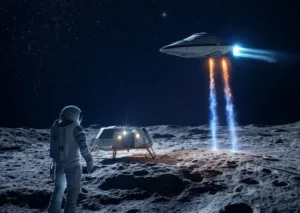
Pluto
Table of Contents
- Introduction
- Early Observations and Predictions in the History of Pluto
- The Official Discovery: A Milestone in the History of Pluto
- Public Reception and Cultural Significance
- Scientific Investigations After Discovery
- The Debate over Pluto’s Status in the History of Pluto
- The Redefinition of a Planet by the IAU
- Missions to Pluto: New Horizons
- Pluto’s Complex System of Moons
- Ongoing Research and Future Perspectives in the History of Pluto
- Conclusion and Reflection
- References
1. Introduction
Astronomers have long sought to understand the outer reaches of our Solar System. Beyond the known gas giants, many believed that hidden worlds waited to be revealed. Indeed, this search yielded one of the most intriguing objects in astronomy. In 1930, Clyde Tombaugh’s careful work led to the confirmation of Pluto. At first, many welcomed it as the ninth planet. Over time, however, scientists discovered many more distant icy bodies. This forced them to confront fresh questions about classification.
The History of Pluto involves more than just one discovery. It spans early predictions, the official finding, and shifting opinions. It also captures scientific excitement and cultural resonance. From its early days as a newly found planet to its eventual classification as a dwarf planet, Pluto’s narrative reflects the evolution of astronomy itself. Astronomers refined telescopes, improved instruments, and challenged old assumptions. With each advancement, Pluto’s unique characteristics emerged. These included a strange orbital path, a complex system of moons, and a surprisingly dynamic surface.
In modern times, missions like New Horizons gave us a detailed look. Before then, Pluto remained a faint point of light. Today, researchers try to understand how Pluto fits into the broader scheme of celestial objects. The History of Pluto is about more than a single body; it is about how definitions shift and knowledge grows. The path from planet to dwarf planet not only shaped Pluto’s identity but also forced us to rethink what defines a planet.
2. Early Observations and Predictions in the History of Pluto
Long before its official discovery, astronomers suspected a distant world lurking beyond Neptune. They observed irregularities in Uranus’s orbit that hinted at another gravitational influence. Percival Lowell dedicated years to the search. He founded the Lowell Observatory in Arizona to find this elusive “Planet X.” Although Lowell died before its confirmation, his meticulous predictions laid the groundwork for the History of Pluto.
During the early 20th century, observers worked with limited technology. They did not yet have space-based telescopes. Moreover, photographic plates captured faint objects only after hours of exposure. They persevered. Errors in orbital calculations made the search challenging. Yet astronomers refused to abandon the quest. They used star catalogs, precise measurements, and patient comparisons.
As predictions refined, the region around the ecliptic became the focal point. Astronomers combed through images taken at intervals. They hoped to spot a moving object against the fixed star background. Indeed, they eventually found a tiny speck shifting across photographic plates. Though faint, this speck matched their expectations.
The early predictions shaped the History of Pluto by setting a certain narrative. This planet, if confirmed, would expand our Solar System. It would also validate the painstaking efforts of Lowell and others who had pursued Planet X. Without these early predictions, Tombaugh’s discovery might not have happened at that time. Thus, the origins of Pluto’s story lie in these patient attempts to catch a ghostly wanderer among distant stars.
3. The Official Discovery: A Milestone in the History of Pluto
In 1930, Clyde Tombaugh achieved what many had tried before him. Using Lowell Observatory’s equipment, he systematically compared photographs of the same star fields taken days apart. After meticulous scrutiny, he identified a moving object. This announcement electrified the astronomical community. Almost immediately, Pluto gained recognition as the ninth planet. The moment Tombaugh confirmed its existence stands as a milestone in the History of Pluto.
Meanwhile, astronomers around the world checked the data. They confirmed the result. Pluto’s size and brightness were not well understood, but initial enthusiasm overshadowed such uncertainties. This new world seemed to promise deeper insights into planetary formation.
Despite the excitement, some remained cautious. They wondered if this object truly accounted for the orbital anomalies that had guided the search. However, public fascination soared. Newspapers hailed Tombaugh’s discovery as monumental. Schools updated textbooks. Children memorized the new planetary lineup.
Additionally, astronomers soon realized Pluto was much smaller than Earth. Still, they did not challenge its planetary status at first. They had found a new world, and that achievement mattered. As decades passed, the initial thrill faded, but the discovery’s importance never did. It provided astronomers with fresh perspectives. Over time, improved instruments revealed Pluto’s secrets. Although classification debates would arise later, the official recognition of Pluto in 1930 remains a key event. It marked a turning point that forever altered the celestial map and influenced the History of Pluto.
4. Public Reception and Cultural Significance
Pluto’s addition to the planetary family captured the public imagination. People were eager to embrace a mysterious, distant world. It expanded the Solar System’s boundaries and inspired curiosity. Children learned about Pluto in school. Artists and writers referenced it, embedding Pluto in popular culture. The name itself, chosen from classical mythology, contributed to the planet’s allure. It carried the weight of ancient stories, connecting modern discoveries to timeless narratives.
For decades, Pluto’s image remained fuzzy. Yet its mystique thrived in literature, documentaries, and movies. Its status as the ninth planet became ingrained in educational materials. Many felt that understanding Pluto offered insights into our cosmic neighborhood. Interest persisted, even though only limited data existed. Pluto’s remoteness prevented detailed study for much of the 20th century. Still, enthusiasm persisted.
However, changing perceptions would later challenge public sentiment. When astronomers reconsidered what it meant to be a planet, the news stirred intense emotion. Many who had grown up with Pluto felt protective. They did not want to see it downgraded. They had invested in Pluto as part of a familiar list. This cultural attachment highlights how public views shape our relationship with celestial objects.
Though cultural significance does not alter scientific facts, it underscores the human element. Our understanding of cosmic objects extends beyond data points. It involves history, tradition, and feeling. Pluto’s cultural role, formed over generations, became part of its story and influenced how the world reacted to changing definitions.
5. Scientific Investigations After Discovery
Following its discovery, scientists tried to understand Pluto’s nature. They measured its brightness, estimated its size, and studied its orbital characteristics. With time, astronomers recognized its unusual path. Unlike the gas giants, Pluto followed a more eccentric orbit. This orbit sometimes brought it closer to the Sun than Neptune. Such an odd pattern raised many questions. Did Pluto form where it currently resides, or did it migrate?
Moreover, improvements in telescopes and detectors offered clearer glimpses. Spectroscopic analysis revealed Pluto’s icy surface. Gradually, researchers discovered that Pluto shared features with other Trans-Neptunian Objects (TNOs). This realization suggested that Pluto might be part of a broader population. It was not alone in the distant reaches of our Solar System.
As scientists learned more, the History of Pluto shifted from simple classification to complex investigation. They compared Pluto with similar bodies to understand its composition. Some suspected that Pluto and its largest moon, Charon, formed from a giant impact. New theoretical models attempted to explain its peculiar system. Meanwhile, technology advanced rapidly, enabling more precise measurements. Instruments that once struggled to detect faint objects now offered detailed spectra.
Ultimately, these investigations enriched the History of Pluto by revealing a world far more dynamic than a mere icy rock. They suggested layered ice, possible geological activity, and atmospheric phenomena. By the late 20th century, Pluto was recognized as a key puzzle piece in understanding the outer Solar System’s structure and formation processes.
6. The Debate over Pluto’s Status in the History of Pluto
By the 1990s, astronomers found many other icy bodies beyond Neptune. Some, like Eris, rivaled Pluto in size. These discoveries complicated the picture. Pluto seemed less unique. Instead, it appeared as one object among many in the Kuiper Belt. This prompted a serious debate. Should Pluto remain a planet, or should it join a new category?
Some astronomers argued that Pluto’s small size and location made it more akin to other Kuiper Belt Objects. Others insisted that Pluto’s historical status and cultural importance deserved respect. Textbooks, educational materials, and even public perception hung in the balance. The History of Pluto during this period involved intense discussion over what defines a planet.
As more TNOs emerged, the problem grew. If Pluto remained a planet, then many similar objects might qualify. That would swell the planetary roster beyond the traditional nine. Some worried that this would dilute the concept of a planet. Meanwhile, the term “dwarf planet” was introduced as a compromise.
Opposing views intensified. At professional meetings, astronomers debated the nuances. They weighed orbital dominance, composition, and formation history. Each new observation pushed the conversation forward. The uncertainty lasted until an official decision came from the International Astronomical Union (IAU). The debate’s outcome would reshape the solar family tree. It would also influence how future generations learned the Solar System’s lineup, marking another crucial chapter in the History of Pluto.
7. The Redefinition of a Planet by the IAU
In 2006, the IAU held a critical assembly in Prague. Astronomers voted on a formal definition of a planet. Under this definition, a planet must orbit the Sun, have enough mass for a round shape, and clear its orbital zone. Pluto met the first two criteria, but not the third. It shared its orbital neighborhood with countless Kuiper Belt objects.
Therefore, Pluto became the prototype of a new category: dwarf planet. It joined other objects like Eris and Ceres. While some celebrated clarity, many mourned the loss of the ninth planet. Educators had to revise lesson plans. Publishers updated textbooks. The public reaction ranged from acceptance to outcry. People wrote letters, started petitions, and voiced disappointment online. Nevertheless, the scientific community mostly supported the move. It reflected evolving knowledge and rigorous standards.
This redefinition affected the History of Pluto by cementing its new identity. Pluto now served as a key example for understanding the diversity of solar system bodies. It was no longer an oddball planet but a representative of a larger population. The IAU’s decision prompted fresh discussions about the nature of celestial classification. Astronomers realized that definitions change with discoveries, and this adaptability enriches science.
The new status did not diminish Pluto’s importance. Instead, it highlighted that naming conventions are tools, not sacred truths. Pluto’s story showcases astronomy’s dynamic nature. As understanding deepens, categories evolve. Pluto’s reclassification is a reminder that scientific knowledge is always in motion.
8. Missions to Pluto: New Horizons
For decades, Pluto remained a point of light. Then NASA’s New Horizons spacecraft launched in 2006, just months after Pluto’s reclassification. This mission aimed to provide a close-up view. It would reveal Pluto’s surface features, atmosphere, and interaction with its moons. Nearly a decade later, in 2015, New Horizons flew by Pluto, capturing images and data that transformed our understanding.
The spacecraft’s instruments returned stunning photos: towering ice mountains, vast plains of frozen nitrogen, and a surprisingly active surface. Scientists gasped. Pluto was not a static chunk of ice, but a dynamic world with geological processes. Data showed evidence of a thin atmosphere, shifting glaciers, and complex chemical compositions. This mission enriched the History of Pluto by offering firsthand exploration.
Meanwhile, the public followed New Horizons’ journey with keen interest. Detailed images appeared in the news, online, and in classrooms worldwide. The encounter proved that distance did not limit discovery. Even from billions of kilometers away, Pluto inspired awe.
This mission also provided us with a rich source of information. It confirmed that dwarf planets can hold intricate landscapes and potential clues to solar system evolution. The data collection continues as scientists analyze every byte of information.
New Horizons not only answered questions but also raised new ones. Understanding Pluto’s geology, composition, and atmosphere has only begun. Future missions may build on this work, ensuring that Pluto’s legacy endures. The spacecraft’s success stands as a testament to human curiosity and technological prowess.
9. Pluto’s Complex System of Moons
Pluto does not journey through space alone. It travels with a collection of moons, the largest being Charon. This sizable companion is nearly half Pluto’s size. Together, they form a unique binary system. Both orbit a common barycenter outside Pluto’s surface, unlike most planet-moon pairs. This special relationship intrigues astronomers.
In addition to Charon, Pluto hosts four smaller moons: Styx, Nix, Kerberos, and Hydra. They orbit in a resonant pattern, suggesting a stable configuration influenced by gravitational interactions. Researchers ponder how these moons formed. Some suspect a giant impact might have created Charon and the other moons. Others explore different scenarios based on orbital dynamics and compositional data.
The detailed observations from New Horizons helped confirm these ideas. High-resolution images revealed cratered surfaces, curious color patterns, and irregular shapes. By studying Pluto’s system of moons, scientists gain insight into how small bodies interact and evolve in the distant reaches of the Solar System. These insights enhance the History of Pluto by showing that classification debates are only one part of its story.
Meanwhile, comparing Pluto’s moons to other satellite systems highlights key differences and similarities. Understanding these connections may shed light on planetary formation and migration. Pluto’s family does not exist in isolation. It is part of a cosmic web that extends through the Kuiper Belt and beyond.
In essence, Pluto’s complex system of moons opens windows into processes that shaped our Solar System’s architecture. Each discovery adds new layers to Pluto’s enduring narrative.
10. Ongoing Research and Future Perspectives in the History of Pluto
Pluto continues to inspire investigation. Scientists analyze data from New Horizons to understand its internal structure, surface chemistry, and atmospheric loss. Earth-based telescopes and the Hubble Space Telescope still observe Pluto to track changes over time. Long-term monitoring detects subtle variations in brightness and atmospheric composition. These efforts ensure that the History of Pluto remains dynamic and evolving.
Additionally, new missions may visit the Kuiper Belt, providing broader context. These journeys could compare Pluto to objects beyond its orbit. With improved technology, we may find even more dwarf planets, each with its own story. By studying Pluto and its neighbors, we refine our definitions and theories.
Future telescopes, such as the James Webb Space Telescope, will peer deeper into the solar outskirts. They may reveal hidden features or detect faint organic compounds. Such findings might reshape our understanding of planetary evolution and habitability in distant regions.
Theoretical models grow more sophisticated. Researchers simulate Pluto’s past and future, examining how its orbit changes over millions of years. They also explore its formation, seeking clues in chemistry and mineralogy. As data accumulates, the History of Pluto remains a living tapestry, woven from observation, theory, and debate.
In the coming decades, Pluto may serve as a gateway to understanding the Kuiper Belt as a whole. Its changing classification underscores that knowledge is not fixed. It adapts as we learn. Pluto’s future lies in the hands of upcoming generations of curious scientists.
11. Conclusion and Reflection
Pluto’s journey from an anticipated “Planet X” to a celebrated member of the dwarf planet category reveals the evolving nature of scientific inquiry. Early predictions set the stage, while Clyde Tombaugh’s discovery introduced a new world. Over time, advanced instruments uncovered Pluto’s secrets. They showed that Pluto, rather than being a mere point of light, is a complex, active object.
Public fascination and cultural impact reflect the deep connection humans form with distant celestial bodies. Pluto’s reclassification illustrates that scientific definitions adapt. Far from diminishing its importance, this change has elevated Pluto’s role as an example of how astronomy grows. It challenges us to think more deeply about what we label as a planet and why.
The New Horizons mission offered an unprecedented look at Pluto’s landscape. This mission confirmed that dwarf planets hold rich stories. They can reshape our perceptions of solar system formation. Pluto’s family of moons adds complexity, highlighting dynamic processes at the solar system’s edge. Future research will likely further illuminate Pluto’s characteristics and place in a cosmic context.
Ultimately, Pluto’s story symbolizes the resilience of knowledge. It urges us to embrace new evidence and adjust our understanding. We must remain open to updating our classifications as we discover more objects like Pluto. In so doing, we celebrate not just one distant world, but the entire scientific enterprise that dares to explore, question, and grow.
12. References
- NASA Pluto Overview: https://solarsystem.nasa.gov/planets/dwarf-planets/pluto/overview/
- International Astronomical Union (IAU) Pluto/Planet Definition: https://www.iau.org/public/themes/pluto/
- NASA New Horizons Mission: https://www.nasa.gov/mission_pages/newhorizons/overview/index.html
- Astronomical Society of the Pacific (Historical Context): https://astrosociety.org/
Supporting Tables
Table 1: Key Dates in Pluto’s Discovery and Classification
| Date | Event |
|---|---|
| 1906-1916 | Percival Lowell’s search for Planet X |
| 1930 | Clyde Tombaugh discovers Pluto |
| Late 1990s | Numerous Kuiper Belt Objects identified |
| 2006 | IAU reclassifies Pluto as a dwarf planet |
| 2015 | New Horizons flies by Pluto |
Table 2: Comparison of Pluto and Other Dwarf Planets
| Dwarf Planet | Approx. Diameter | Orbital Region | Discovery Date |
|---|---|---|---|
| Pluto | ~2,377 km | Kuiper Belt | 1930 |
| Eris | ~2,326 km | Scattered Disc | 2005 |
| Haumea | ~1,632 km (long) | Kuiper Belt | 2004 |
| Makemake | ~1,430 km | Kuiper Belt | 2005 |
| Ceres | ~940 km | Asteroid Belt | 1801 |






